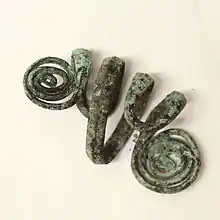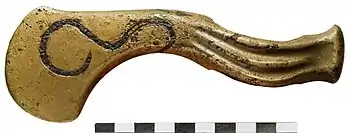
The Koban culture or Kuban culture (c. 1200 to 350 BC),[1] is a late Bronze Age and Iron Age culture of the northern and central Caucasus. It is preceded by the Colchian culture of the western Caucasus and the Kharachoi culture further east.
It is named after the village of Koban, Northern Ossetia, where in 1869 battle-axes, daggers, decorative items and other objects were discovered in a kurgan. Later, further sites were uncovered in the central Caucasus.
Geographical extent

The culture flourished on both sides of the Great Caucasus Range, and extended into the areas of Ingushetia, Kabardino-Balkaria, Karachay-Cherkessia, and North Ossetia-Alania, and South Ossetia. It also reached the high north-western regions of Georgia such as Racha and Svaneti. Some areas of Northeast Caucasus also had Koban settlements, in particular the modern Ingushetia and the western regions of Chechnya.[2]
To the north, the culture extended as far as the Terek River, and to the Laba River in the Krasnodar area.[3]
Description
The early phase of the Koban culture, especially in the west, possibly extends back as far as the 13th century BC, as the recent radiocarbon dates indicate.[2][4]
The Koban culture settlements (as opposed to isolated cemeteries) have been little studied, with the exception of those located in the modern Chechnya, such as near Serzhen-Yurt, and near Bamut; these were major centers from around 11th century BC to around the 7th century BC.[5][6]
The remains include dwellings, cobble bridges, altars, iron objects, bones, and clay and stone objects. There were sickles and stone grain grinders. Grains that were grown included wheat, rye and barley. Cattle, sheep, goats, donkeys, pigs and horses were kept.[5] There were shops, where artisans worked on and sold pottery, stone-casting, bone-carving, and stone-carving. There is evidence for an advanced stage of metallurgy. There was differentiation of professionals organized within clans.[5]
Tli cemetery
The Tli cemetery contained many rich burials. It is located near the village of Tli in South Ossetia, in the Tligom ravine (ru:Тлигомское ущелье). The excavations started at the end of the 19th century, and continued in 1955–1988. B. V. Tekhov excavated more than five hundred burials, with detailed publications.[2]
The earliest burials at Tli cemetery go back to the 16th-14th centuries BC (pre-Koban period). Then the cemetery was used for almost the entire period of existence of the Koban culture.
Ethnic affiliation
.png.webp)
Amjad Jaimoukha believes the Koban culture was primarily Nakh.[5] He argues that while all these cultures probably were made by people included among the genetic ancestors of the Northern Caucasian Nakh (i.e. Chechens and Ingush), it was either the Koban or Kharachoi culture that was the first culture made by the cultural and linguistic ancestors of the Chechens (meaning the Chechens first arrived in their homeland 3000–4000 years ago). Jaimoukha postulates that the end of the Koban culture was brought about by Scythian invasions.[5]
Johanna Nichols has written that, "There is fairly seamless archeological continuity for the last 8000 years or more in central Daghestan, suggesting that the Nakh-Daghestanian language family is long indigenous."[12]
A genetic study in 2020 analysing samples from Klin-Yar communities, including the Koban culture, found that the ancient population had one sample of Haplogroup D-Z27276, which is associated with the modern Tibetan people. Other haplogroups were Haplogroup J1 and Haplogroup G-M285.[13]
The arts
The surviving bronze items reflect the high level of development of the artistic skills of the ancient masters. In museums and private collections there are objects with remnants of vitreous enamel, which confirm that they began to decorate metal products with fired enamel.
 Bronze buckles with vitreous enamel
Bronze buckles with vitreous enamel Bronze with remnants of vitreous enamel
Bronze with remnants of vitreous enamel
See also
References
- ↑ Boulygina, Eugenia, et al., (2020). "Mitochondrial and Y-chromosome diversity of the prehistoric Koban culture of the North Caucasus", in: Journal of Archaeological Science: Reports, Volume 31, June 2020, 102357, Introduction: "[T]he Koban culture was widespread on both sides of the Great Caucasus Range during the 13th/12th – 4th centuries BC. It is widely known because of its advanced metallurgy as well as developed terraced agriculture (Korobov and Borisov, 2013)."
- 1 2 3 P. Kohl, Viktor Trifonov, The prehistory of the Caucasus: internal developments and external interactions. 2014
- ↑ Kozenkova 1977, 2004; Tsokur 2004
- ↑ Belinsky et al. 2009
- 1 2 3 4 5 Jaimoukha. Chechens. Page 23-28.
- ↑ Evgeni Chernykh, Ancient Metallurgy in the USSR: The Early Metal Age. CUP Archive, 1992, ISBN 0521252571 p278
- ↑ Jeong, Choongwon; Wang, Ke; Wilkin, Shevan (12 November 2020). "A Dynamic 6,000-Year Genetic History of Eurasia's Eastern Steppe". Cell. 183 (4): 890–904, Figure 1 A, B, C. doi:10.1016/j.cell.2020.10.015. ISSN 0092-8674. PMC 7664836. PMID 33157037.
- ↑ Török, Tibor (July 2023). "Integrating Linguistic, Archaeological and Genetic Perspectives Unfold the Origin of Ugrians". Genes. 14 (7): Figure 1. doi:10.3390/genes14071345. ISSN 2073-4425. PMC 10379071. PMID 37510249.
- ↑ Atlas of World History. Oxford University Press. 2002. p. 51. ISBN 978-0-19-521921-0.
- ↑ Fauve, Jeroen (2021). The European Handbook of Central Asian Studies. Ibidem Press. p. 403. ISBN 978-3-8382-1518-1.
- ↑ Zhang, Fan; Ning, Chao; Scott, Ashley (November 2021). "The genomic origins of the Bronze Age Tarim Basin mummies". Nature. 599 (7884): 256–261. Bibcode:2021Natur.599..256Z. doi:10.1038/s41586-021-04052-7. ISSN 1476-4687. PMC 8580821. PMID 34707286. Overview of key Eurasian geographic regions, features and archaeological sites (24,000-0 BCE)
- ↑ Johanna Nichols (February 1997). "The Ingush (with notes on the Chechen): Background information". University of California, Berkeley. Retrieved 2016-08-11.
- ↑ Boulygina, Eugenia; Tsygankova, Svetlana; Sharko, Fedor; Slobodova, Natalia; Gruzdeva, Natalia; Rastorguev, Sergey; Belinsky, Andrej; Härke, Heinrich; Kadieva, Anna; Demidenko, Sergej; Shvedchikova, Tatiana (2020-06-01). "Mitochondrial and Y-chromosome diversity of the prehistoric Koban culture of the North Caucasus". Journal of Archaeological Science: Reports. 31: 102357. doi:10.1016/j.jasrep.2020.102357. ISSN 2352-409X. S2CID 218789467.
Bibliography
- Nikoloz Gobejishvil (2014), Interrelation of Colchian and Koban Cultures According to Burial Constructions and Funerary Customs (Late Bronze – Early Iron Age) spekali.tsu.ge